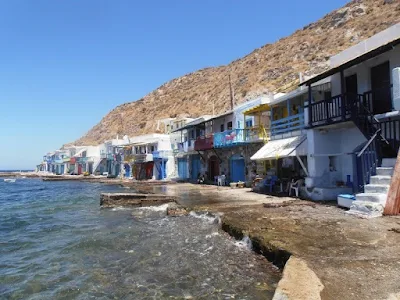I must admit that I am very lucky. I visited the island of Milos, one of the most beautiful Greek islands, along with my best friend Vlasia. She comes from Milos so she knows the island very well. During my stay there she took me to the best places on the island. So here is my list of what to do in Milos island Greece.
Spend the day on the beach
Milos Island is famous for its beaches. It has more than 75 small and big beaches some accessible by land and some by water. Here are some of the best:
Sarakiniko Beach
Located on the north shore of the island, Sarakiniko beach is the most photographed spot of the island. The beach is full of white rocks that reminds you of a lunar landscape.
Firiplaka Beach
Firiplaka is a long beach with white sand, pristine waters and big rocks. It is an organized beach with a small beach bar.
Take a boat tour around the island of Milos
A visit to the island of Milos is incomplete if you don’t do a boat tour around the island. It gives you the chance to swim in places only accessible by boat and see the island from a different angle. There are a lot of tours available and they cost around 50 € per person including food and drinks. I totally recommend the one by sailing boat. All the boat tours in Milos depart from the village of Adamas, they take you across the shoreline of Milos making stops along the way. The highlight of the journey is Kleftiko. There you will be able to swim around the small caves and see the strange rock formations. This tour will take you to many points of interest around Milos.
Visit the beautiful villages of Milos
Klima
You should visit the traditional little village of Klima. This beautiful village has coloured houses that are carved within the rock and are called Syrmata. They have two floors. On the ground floor, the fisherman keep their boats protected at winter when the weather is bad and on the first floor lives the family.
Mantrakia
It is another traditional fisherman’s village in Milos with the houses carved within rocks just like in Klima. It has a few rooms for rent and a taverva.
Stroll the cobbled roads of Plaka
Plaka is the capital of Milos island. It is built on the top of a hill. From there you can enjoy a magnificent view of the gulf of Milos. It is particularly nice during the sunset. The village is full of traditional white –washed houses with colored windows. You will find a lot of restaurants, bars and little shops along the narrow roads. Also, you can visit the archaeological museum that has a replica from the Venus of Milos that is currently on display in the museum of Louvre in Paris.
Eat, the food is delicious!
I must admit that I am a fan of Greek food. I believe you can find tasty food all around Greece but there are some places that are special. Milos island is one of them.
Where to eat in Milos island Greece
So if you are wandering where to eat in Milos I recommend eating in all of these places.
Gialos
This seafront taverna is located in the beautiful seaside village of Apollonia. I have eaten there many times. It offers a big variety of dishes and it’s a great place to eat fresh fish.
Hamos
You will find this traditional taverna in the town of Adamas. The meat and cheese that is being served there is their own production. You should try “pitarakia” fried cheese pie!
Ergina
You will find this traditional taverna in the village of Tripiti. You should get there early in order to find a table in front of the balcony with view of the gulf of Milos. You should eat Kremidopita (onion pie), chicken with homemade lazania, pitarakia, Ergina salad and more.
Where to stay in Milos, Greece
HotelsCombined is a great website to check out to find the most cost-effective accommodation option for you in Milos. It will tell you which hotel booking site has the best price. Here are my picks for the best accommodations in Milos, Greece:
- Thalassitra Village Hotel is located in Adamas village close to local attractions, restaurants, and bars. This family-run hotel offers spacious clean rooms and great breakfast. Check here for the latest prices and more details or check out Tripadvisor Reviews.
- Another great accommodation option in Adamas is Santa Maria Village. Situated 300 m away from the beach and close to restaurants and bars this beautiful hotel offers spacious rooms with balcony, free Wi-Fi, air-conditioning and a swimming pool. Check here for the latest prices and more details or check out Tripadvisor Reviews.
- A great accommodation option in Pollonia is Nefeli Sunset Studios. Located just 4 minutes on foot from the beach and the restaurants and bars of the area this family-run hotel offers spacious rooms with balcony, free wi-fi, and air conditioning. Check here for the latest prices and more details or check out Tripadvisor Reviews.
- Villa Gallis in Pollonia offers spacious rooms overlooking the Aegean with a nice swimming pool, free Wi-Fi, air-conditioning and within walking distance from the beach and local amenities. Check here for the latest prices and more details or check out Tripadvisor Reviews.
- For more information about Milos island, Greece you can check Bel Around the World’s Guide to the Island of Milos.
So have you ever been to Milos island? What did you enjoy the most?
Source






Comments
Post a Comment